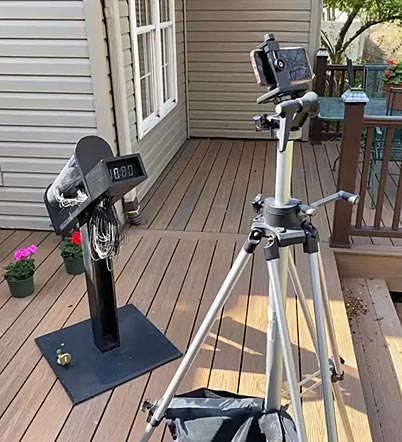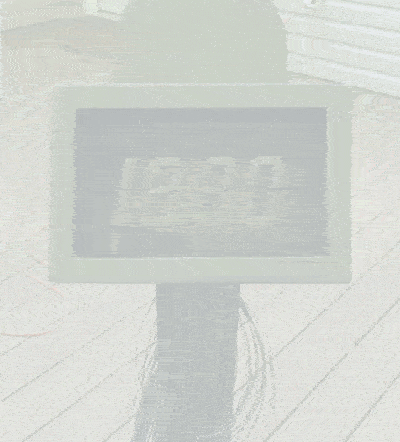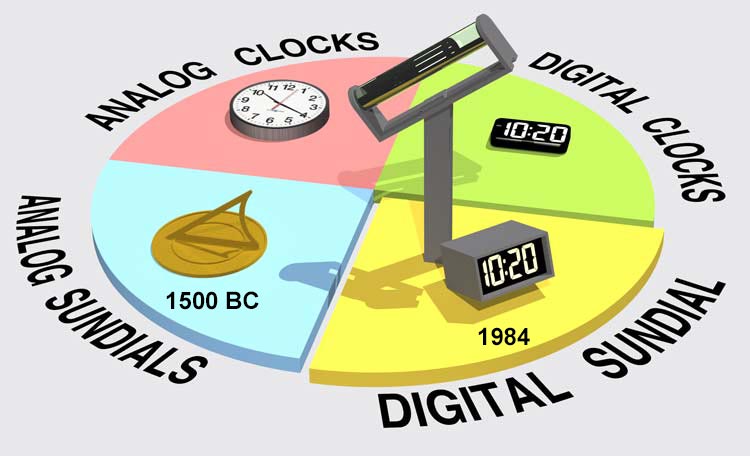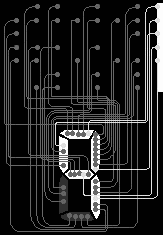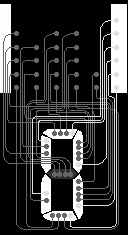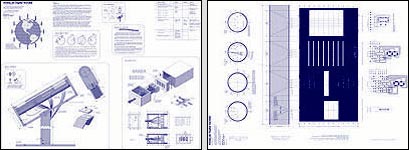Digital Sundial
Hines Digital Sundial
A nearby roof blocked the sun until 9:40 AM.
| The digital sundial, invented by Steve Hines in 1984, and patented in 1988, shows the time with a true 7-segment numerical display. The sun shines through slits in the encoder, onto the ends of optical fibers, that route the light to the 7-segment numerals in the display. |  |
The four categories of timekeeping devices:
All timekeeping devices fall into one of four categories, analog or digital clocks, or analog or digital sundials. The digital sundial category has gone without an example for 3,600 years until 1984, and is recognized by the North American Sundial Society, Wikipedia, and Siri (ask your phone) as the first true digital sundial.
Construction:
Optical fibers are epoxied in holes in the clear Plexiglas encoding cylinder (the gnomon of analog sundials). The opposite ends of the fibers are clear epoxied to backs of the segments, in the numerical display.
The sundial in a museum:
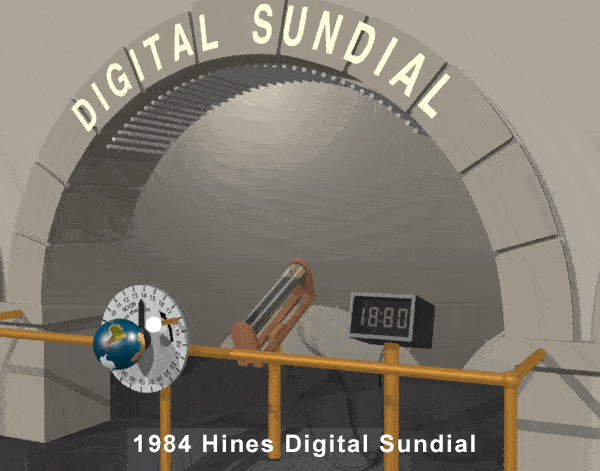 |
print |
The digital sundial can be displayed in a museum setting where visitors rotate a “sun” handle around a globe, to sequence the overhead “sunlight”.
Advantages of the Hines digital sundial over other other sundials:
- It provides the time at a glance.
- The display can be at any convenient distance, hundreds or thousands of feet from the encoding cylinder.
- The time is displayed in 10-min. increments.
- This is the world’s first optical analog-to-digital converter. Other A-to-D converters are electronic.
Advantage of the Hines digital sundial over other timekeeping devices of any type:
- A digital clock without electrical power.
Sundial Resources:
- ePlastics, 5″-dia. cast acrylic tube
- Harvard Univ. sundial collection
- Industrial Fiber Optics, optical fiber
- National Maritime Museum, Greenwich, England
- North American Sundial Society
- Smithsonian Institution, Washington DC
- Sundial Magazine, England
- Wikipedia
.
How it works:
As the sun moves across the sky, sunlight shines through slits in the top of the encoding cylinder and sweeps over the ends of optical fibers in the bottom of the cylinder to illuminate the segments of the numerals. The following animations are without any phase relationship.
Blueprints:
3D-printed shadow-mask sundials appeared in approximately 2015, 31 years after the 1984 Hines’ digital sundial, and do not use actual 7-segment numerals. The Hines’ Digital Sundial is the only true digital sundial with 7-segment numerals.
Activity:
- Siri, Alexa and Google describe the Hines’ Sundial as “the world’s first digital sundial”, Feb. 2025.
- “Great design“, Jean-Baptiste Rouquier, Dec. 27, 2022
- plans ordered by Edgar Kogler, April 24, 2018
- North American Sundial Society (NASS) declares it “The First True Digital Sundial“, October 2, 2014
- plans ordered by Pat O’Grady, Sept. 4, 2014
- plans ordered by Bret Niemeyer, June 28, 2011
- plans ordered by Punjab Engineering College, India, February 6, 2008
- plans ordered by Charles Ashcroft, Sept. 7, 2007
- incorporated in paper presented by Bob Kellogg, at the North American Sundial Society conference in Banff, Alberta, Canada, August 21-24, 2003
- plans ordered by Till Liepmann, April 1, 2002
- information requested by Sundials magazine, November 29, 2001
- plans ordered by Hans Sassenburg, May 1, 1999
- plans ordered by James Luttrell, January 21, 1995
- plans ordered by Robert Siebert, Nov. 1, 1994
- plans ordered by William Georgian, September 27, 1994
- plans ordered by Robert McGrath, September 10, 1994
- plans ordered bt Phillip Rogen, September 6, 1994
- Solar Today Magazine, August 20, 1994 issue, p. 39
- plans ordered by Rick Steenblik, September 18, 1988
- U.S. Patent 4,782,472, issued to S. Hines, November 1, 1988
HinesLab
Virginia Beach, VA, USA

